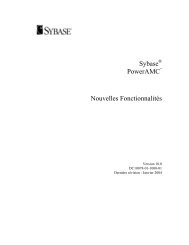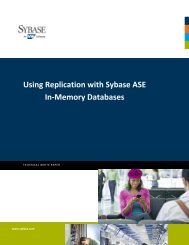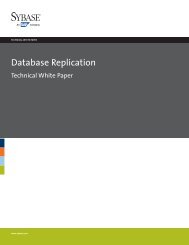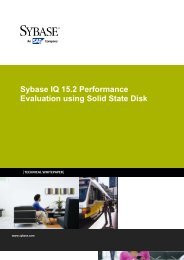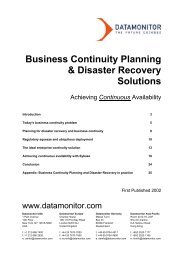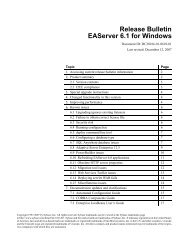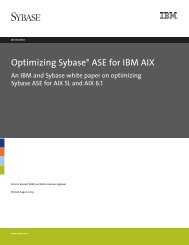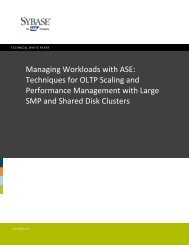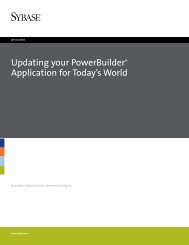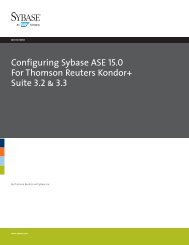A Practical Hardware Sizing Guide for Sybase IQ
A Practical Hardware Sizing Guide for Sybase IQ
A Practical Hardware Sizing Guide for Sybase IQ
You also want an ePaper? Increase the reach of your titles
YUMPU automatically turns print PDFs into web optimized ePapers that Google loves.
� Temporary cache – This is set via the –iqtc parameter to size the temporary, transient<br />
data cache<br />
Main and Temporary Cache<br />
Main cache is used to house static, persistent user data and the system structures controlling<br />
access to the user data in the <strong>for</strong>m of the <strong>IQ</strong> indexes. Temporary cache is that transient, volatile<br />
area of memory. Temporary cache is used to house temporary tables, internal work tables, and<br />
any other data structures that are temporary in nature.<br />
Once the amount of RAM that can be allocated to the caches has been determined, the next step<br />
is to compute the ratio between main and temporary cache. For typical systems a starting point<br />
is to split the available RAM <strong>for</strong> caches and allocate 40% of that <strong>for</strong> main cache and 60% <strong>for</strong><br />
temporary cache.<br />
With the advent of the 3-byte FP index, main cache plays a role in the use of that index type. As<br />
the main cache size is increased (see below), <strong>IQ</strong> will allow more distinct values to be represented<br />
in the 3-byte FP structures. As such, it is often advised to increase the main cache use from<br />
40% to 50% and decrease the temp cache use to 50% while the initial data is being loaded into<br />
the tables.<br />
In systems that per<strong>for</strong>m more loads than queries, more memory is typically allocated to the<br />
temporary cache to help with the HG or WD index processing keeping in mind, though, that<br />
lowering the main cache size can restrict the use of the 3-byte FP index.<br />
In systems that tend to process more queries than loads, more memory is typically allocated to<br />
the main cache to help reduce the amount of trips that <strong>IQ</strong> must make to the main store to<br />
retrieve user data. The caveat to this is those environments where a considerable amount of<br />
temporary tables, group bys, or order bys are being used. In those situations, revert to the<br />
40/60 memory split.<br />
In all situations, the caches should be monitored and adjusted according to the use patterns.<br />
Optimized Fast Projection Index Main Cache Memory Use<br />
In <strong>IQ</strong> 12 when an optimized Fast Projection (FP) index was used, the index would follow the<br />
basic rule that a 1-byte FP (FP1) would be converted to a 2-byte FP (FP2) and finally to a flat<br />
style FP should the cardinality increase and cross the 1-byte and 2-byte FP index boundaries of<br />
255 and 64k, respectively.<br />
<strong>IQ</strong> 15 changes this behavior due to the addition of an optimized 3-byte FP index.<br />
Two new options were added to control the amount of main cache to be used <strong>for</strong> storing the<br />
lookup pages <strong>for</strong> the optimized FP indexes: FP_LOOKUP_SIZE and FP_LOOKUP_SIZE_PPM.<br />
FP_LOOKUP_SIZE controls the absolute amount of RAM (16 MB by default) that the lookup pages<br />
can consume while FP_LOOKUP_SIZE_PPM (2500 parts per million by default) sets the same limit<br />
based upon a percentage of the main cache.<br />
The maximum number of lookup pages used in <strong>Sybase</strong> <strong>IQ</strong> is controlled by the FP_LOOKUP_SIZE<br />
option and the FP_LOOKUP_SIZE_PPM option, whichever value is smaller. When the threshold is<br />
crossed <strong>for</strong> any of the optimized FP indexes, that index will automatically be converted to a flat<br />
FP structure.<br />
Final<br />
9



